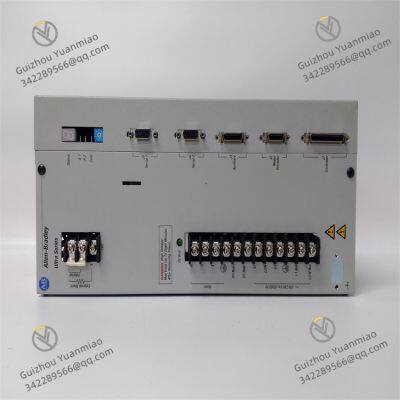Product Description
I. Overview
1398-DDM-075 is a high-performance servo driver mainly used to control the operation of servo motors, playing an important role in precise driving and control in the field of industrial automation. It can receive command signals from the controller and achieve precise control of the speed, position, and torque of the servo motor by accurately adjusting the output voltage and current, thereby ensuring that the relevant mechanical equipment operates stably according to preset trajectories and parameters.
This servo driver is equipped with advanced control algorithms and strong computing capabilities, enabling it to quickly respond to control commands, effectively suppress external interference, and ensure the stability and accuracy of motor operation. It has strong compatibility and can be used with various models of servo motors, making it suitable for occasions with high requirements for motion control accuracy, such as precision machining, automated assembly lines, and robotics, providing strong support for high-precision and efficient industrial production.

II. Technical Parameters
Rated Output
Rated Power: 7.5kW (specific value is subject to the product manual), which can provide sufficient power output for the servo motor to meet medium and high-power driving needs.
Rated Current: A specific value (specific value is subject to the product manual), which stably outputs current under rated working conditions to ensure the normal operation of the motor.
Output Voltage: Adjusted according to the input power supply and motor parameters, usually adapted to three-phase AC motors (specific voltage range is subject to the product manual).
Power Parameters
Input Power Supply: Supports three-phase AC power input (specific voltage level is subject to the product manual, such as 380V AC), adapting to common power supply systems in industrial sites.
Power Frequency: 50/60Hz (specific value is subject to the product manual), compatible with power grid frequency standards in different regions.
Control Performance
Control Modes: Supports multiple control modes such as position control, speed control, and torque control (specific supported modes are subject to the product manual), and users can flexibly select and switch according to actual needs.
Position Control Accuracy: Has extremely high position control accuracy (specific accuracy value is subject to the product manual), enabling micron-level or even higher precision positioning to meet the requirements of precision machining and assembly.
Speed Adjustment Range: Has a wide speed adjustment range (specific range is subject to the product manual), which can achieve smooth adjustment from extremely low speed to maximum speed, ensuring the smooth operation of the motor.
Response Frequency: Has a high response frequency (specific value is subject to the product manual), which can quickly respond to changes in control commands and reduce dynamic following errors.
Communication and Interfaces
Communication Interfaces: Equipped with corresponding communication interfaces (such as RS-232, RS-485, or specific industrial bus interfaces, specific ones are subject to the product manual), which can perform data interaction and communication with the upper controller to realize remote control and parameter setting.
Input/Output Interfaces: Provides rich digital and analog input/output interfaces (specific quantity and type are subject to the product manual) for connecting external sensors, buttons, indicator lights, and other equipment to realize signal collection and output of control commands.
Protection Functions
It has multiple protection functions such as overcurrent, overvoltage, undervoltage, overload, overheating, motor stall, and encoder failure (specific protection types are subject to the product manual). When an abnormal situation occurs, it can quickly cut off the output to protect the driver and motor from damage.
Environmental Adaptability
Operating Temperature: Can work stably within a certain temperature range such as 0°C-50°C (specific range is subject to the product manual), adapting to the temperature environment of industrial sites.
Relative Humidity: Can operate normally in a relative humidity environment of 5%-95% (non-condensing) (specific parameters are subject to the product manual).
Protection Level: Has a certain protection level (such as IP20, specific level is subject to the product manual), suitable for installation in control cabinets to prevent dust and foreign objects from entering.

III. Functional Features
High-Precision Control: 1398-DDM-075 adopts advanced vector control algorithms and high-precision feedback detection technology (usually used with encoders), which can accurately control the position, speed, and torque of the servo motor. It has high control precision and fast dynamic response, ensuring the accurate movement trajectory of mechanical equipment and meeting the needs of high-precision scenarios such as precision machining and assembly.
Stable and Reliable Operation: It has built-in perfect protection functions, which can effectively deal with various abnormal working conditions such as overcurrent, overvoltage, and overload, timely protect the driver and motor, and reduce the risk of equipment damage. At the same time, it uses high-quality components and rigorous circuit design, has strong anti-interference ability, and can operate stably in complex industrial environments, reducing fault downtime.
Flexible Control Modes: Supports multiple control modes, and users can select the appropriate control mode according to actual application needs. For example, position control mode is selected in precision positioning scenarios, speed control mode is selected in constant speed operation scenarios, and torque control mode is selected in scenarios where output force needs to be controlled, which improves the applicability and flexibility of the equipment.
Convenient Parameter Setting and Debugging: Equipped with a user-friendly operation interface or parameter setting and debugging through special software (specific method is subject to the product manual), users can conveniently configure various parameters of the driver, such as speed loop gain, position loop gain, acceleration, etc., to optimize system performance. At the same time, it supports online monitoring and fault diagnosis functions, facilitating quick troubleshooting and problem-solving.
Good Compatibility: It can be seamlessly integrated with Rockwell Automation's PLCs, motion controllers, and other products, and is also compatible with controllers and servo motors of other brands (subject to meeting corresponding interface and parameter requirements), facilitating users' system integration and upgrade transformation, and reducing the difficulty and cost of system construction.

IV. Common Faults and Solutions
Driver Failure to Start
Phenomenon: After power is turned on, the driver has no response, cannot start, or the indicator light is not on.
Causes and Solutions
Power Supply Issues: Power is not connected, input voltage is abnormal, or power line is faulty. Check if the power connection is firm and ensure the power switch is turned on; use a multimeter to measure the input voltage and confirm it is within the specified voltage range of the driver; check if the power line has faults such as open circuit or short circuit, and repair or replace the line.
Driver Fault: The internal power module or control circuit of the driver is damaged. If it still cannot start after eliminating power supply issues, there may be an internal fault in the driver. It is necessary to contact professional maintenance personnel for inspection and repair, and replace the driver if necessary.
Unstable Motor Operation

Driver Alarm (Overcurrent, Overvoltage, etc.)
Phenomenon: During the operation of the driver, alarm prompts such as overcurrent, overvoltage, and overload appear, and the driver stops working.
Causes and Solutions
Overcurrent: Motor short circuit, excessive load, or driver output circuit fault. Check if the motor windings are short-circuited, and repair or replace the motor if there is a short circuit; reduce the load to ensure operation within the rated load range; if the driver output circuit is suspected to be faulty, contact professional personnel for inspection.
Overvoltage/Undervoltage: The input power supply voltage exceeds or is lower than the rated range. Check the input power supply voltage, and install a voltage stabilizer if the voltage fluctuates greatly; if the grid voltage is abnormal for a long time, contact the power supply department to solve it.
Overload: The motor load exceeds the rated value or the operation time is too long. Check the load situation, reduce the load or replace the driver and motor with larger capacity; avoid long-term full-load operation of the motor and arrange appropriate shutdown rest.
Communication Fault
Allen-Bradley 1784-KTX Communication Interface Card
Allen-Bradley 1784-PCIC Communication Interface Card
Allen-Bradley 1784-PKTX Network Interface Card
Allen-Bradley 1797-PS2E2 FLEX Ex Power Supply Module
Allen-Bradley 2094-BC04-M03-S Kinetix 6000 Integrated Axis Module
Allen-Bradley 2094-BM01-S Class Axis Module


Allen-Bradley 2094-EN02D-M01-S1 Kinetix 6200/6500 Control Module
Allen-Bradley 2098-DSD-020X Ultra 3000 Digital Servo Drive
Allen-Bradley 5204-DFNT-PDPMV1 EtherNet/IP Communication Module
Allen-Bradley 5302-MBP-MCM4MB EtherNet/IP Communication Module
Allen-Bradley 80026-044-06-R Power Supply
Allen-Bradley 80190-300-01-R Original Packaging Module
Allen-Bradley 81001-450-53-R Circuit Board
Allen-Bradley 80190-580-01-R Drive Processor Module
Allen-Bradley 81001-340-71-R High-Performance PLC Module
Allen-Bradley 81007-465-51-R Voltage Sensing Board
Emerson 1C31194G04 Valve Positioner Module
Emerson A6110 9199-00001 AMS Shaft Relative Vibration Monitor
 yezi
Hi there! Welcome to my shop. Let me know if you have any questions.
yezi
Hi there! Welcome to my shop. Let me know if you have any questions.






